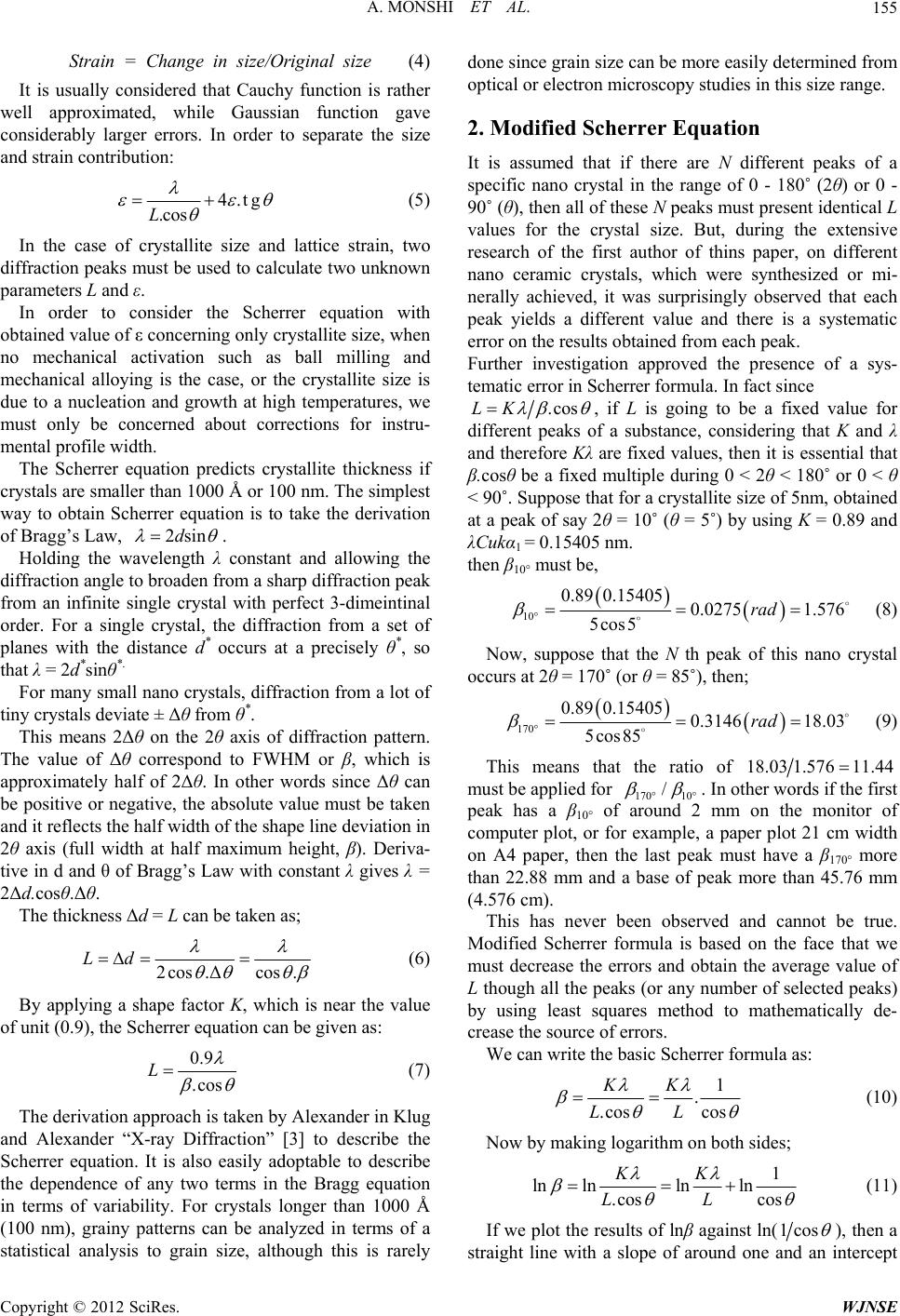
A. MONSHI ET AL. 155
Strain = Change in size/Original size (4)
It is usually considered that Cauchy function is rather
well approximated, while Gaussian function gave
considerably larger errors. In order to separate the size
and strain contribution:
4.tg
.cosL
(5)
In the case of crystallite size and lattice strain, two
diffraction peaks must be used to calculate two unknown
parameters L and ε.
In order to consider the Scherrer equation with
obtained value of ε concerning only crystallite size, when
no mechanical activation such as ball milling and
mechanical alloying is the case, or the crystallite size is
due to a nucleation and growth at high temperatures, we
must only be concerned about corrections for instru-
mental profile width.
The Scherrer equation predicts crystallite thickness if
crystals are smaller than 1000 Å or 100 nm. The simplest
way to obtain Scherrer equation is to take the derivation
of Bragg’s Law, 2sind
.
Holding the wavelength λ constant and allowing the
diffraction angle to broaden from a sharp diffraction peak
from an infinite single crystal with perfect 3-dimeintinal
order. For a single crystal, the diffraction from a set of
planes with the distance d* occurs at a precisely θ*, so
that λ = 2d*sinθ*.
For many small nano crystals, diffraction from a lot of
tiny crystals deviate ± Δθ from θ*.
This means 2Δθ on the 2θ axis of diffraction pattern.
The value of Δθ correspond to FWHM or β, which is
approximately half of 2Δθ. In other words since Δθ can
be positive or negative, the absolute value must be taken
and it reflects the half width of the shape line deviation in
2θ axis (full width at half maximum height, β). Deriva-
tive in d and θ of Bragg’s Law with constant λ gives λ =
2Δd.cosθ.Δθ.
The thickness Δd = L can be taken as;
2cos .Δcos.
Ld
(6)
By applying a shape factor K, which is near the value
of unit (0.9), the Scherrer equation can be given as:
0.9
.cos
L
(7)
The derivation approach is taken by Alexander in Klug
and Alexander “X-ray Diffraction” [3] to describe the
Scherrer equation. It is also easily adoptable to describe
the dependence of any two terms in the Bragg equation
in terms of variability. For crystals longer than 1000 Å
(100 nm), grainy patterns can be analyzed in terms of a
statistical analysis to grain size, although this is rarely
done since grain size can be more easily determined from
optical or electron microscopy studies in this size range.
2. Modified Scherrer Equation
It is assumed that if there are N different peaks of a
specific nano crystal in the range of 0 - 180˚ (2θ) or 0 -
90˚ (θ), then all of these N peaks must present identical L
values for the crystal size. But, during the extensive
research of the first author of thins paper, on different
nano ceramic crystals, which were synthesized or mi-
nerally achieved, it was surprisingly observed that each
peak yields a different value and there is a systematic
error on the results obtained from each peak.
Further investigation approved the presence of a sys-
tematic error in Scherrer formula. In fact since
.cosLK
, if L is going to be a fixed value for
different peaks of a substance, considering that K and λ
and therefore Kλ are fixed values, then it is essential that
β.cosθ be a fixed multiple during 0 < 2θ < 180˚ or 0 < θ
< 90˚. Suppose that for a crystallite size of 5nm, obtained
at a peak of say 2θ = 10˚ (θ = 5˚) by using K = 0.89 and
λCukα1 = 0.15405 nm.
then β10 must be,
10
0.89 0.154050.0275 1.576
5cos5 rad
(8)
Now, suppose that the N th peak of this nano crystal
occurs at 2θ = 170˚ (or θ = 85˚), then;
170
0.89 0.154050.3146 18.03
5cos85 rad
(9)
This means that the ratio of 18.03 1.57611.44
must be applied170 10
/
for
. In other words if the first
peak has a β10 of around 2 mm on the monitor of
computer plot, or for example, a paper plot 21 cm width
on A4 paper, then the last peak must have a β170 more
than 22.88 mm and a base of peak more than 45.76 mm
(4.576 cm).
This has never been observed and cannot be true.
Modified Scherrer formula is based on the face that we
must decrease the errors and obtain the average value of
L though all the peaks (or any number of selected peaks)
by using least squares method to mathematically de-
crease the source of errors.
We can write the basic Scherrer formula as:
1
.
.cos cos
KK
LL
(10)
Now by making logarithm on both sides;
1
ln lnlnln
.cos cos
KK
LL
(11)
If we plot the results of lnβ against ln(1cos
), then a
straight line with a slope of around one and an intercept
Copyright © 2012 SciRes. WJNSE